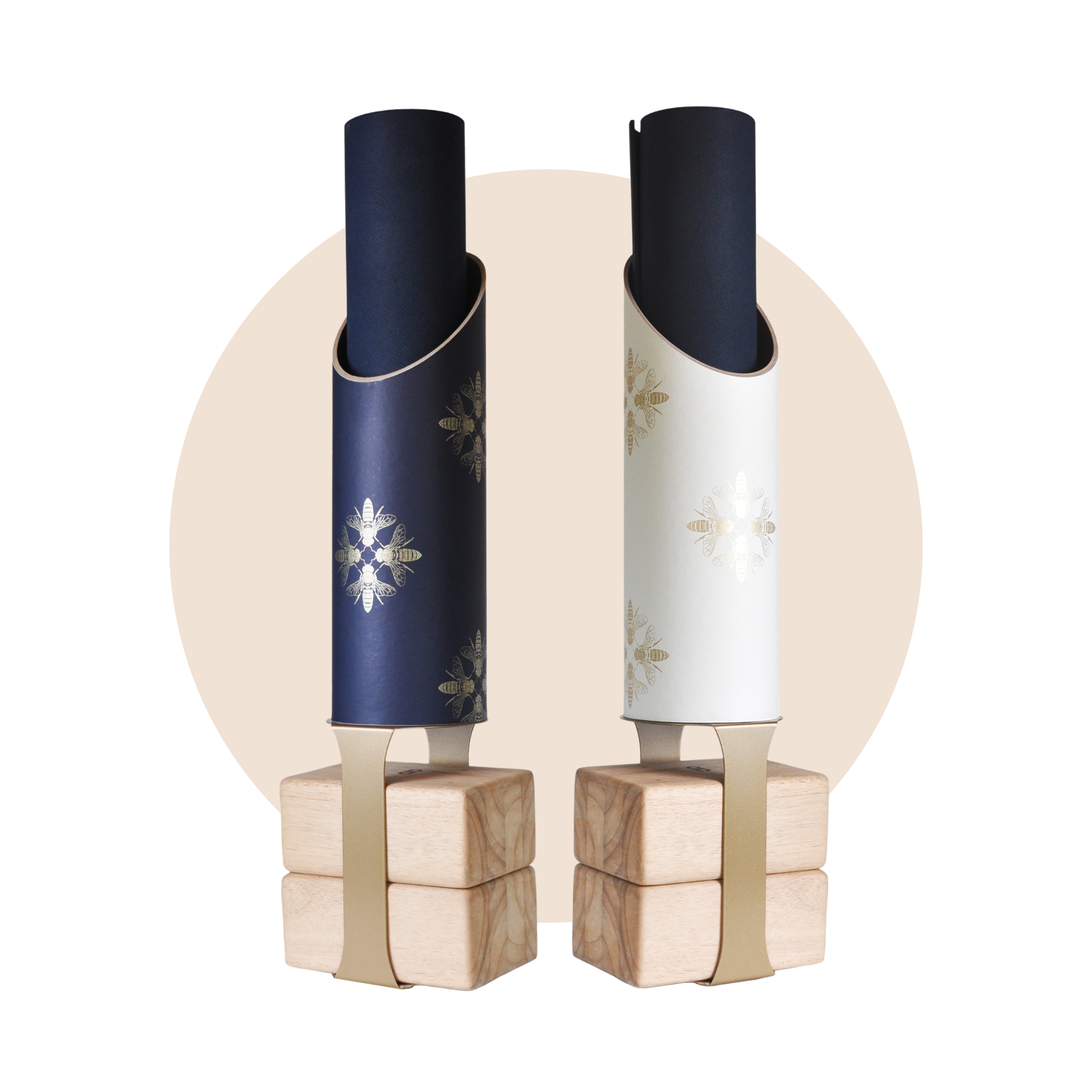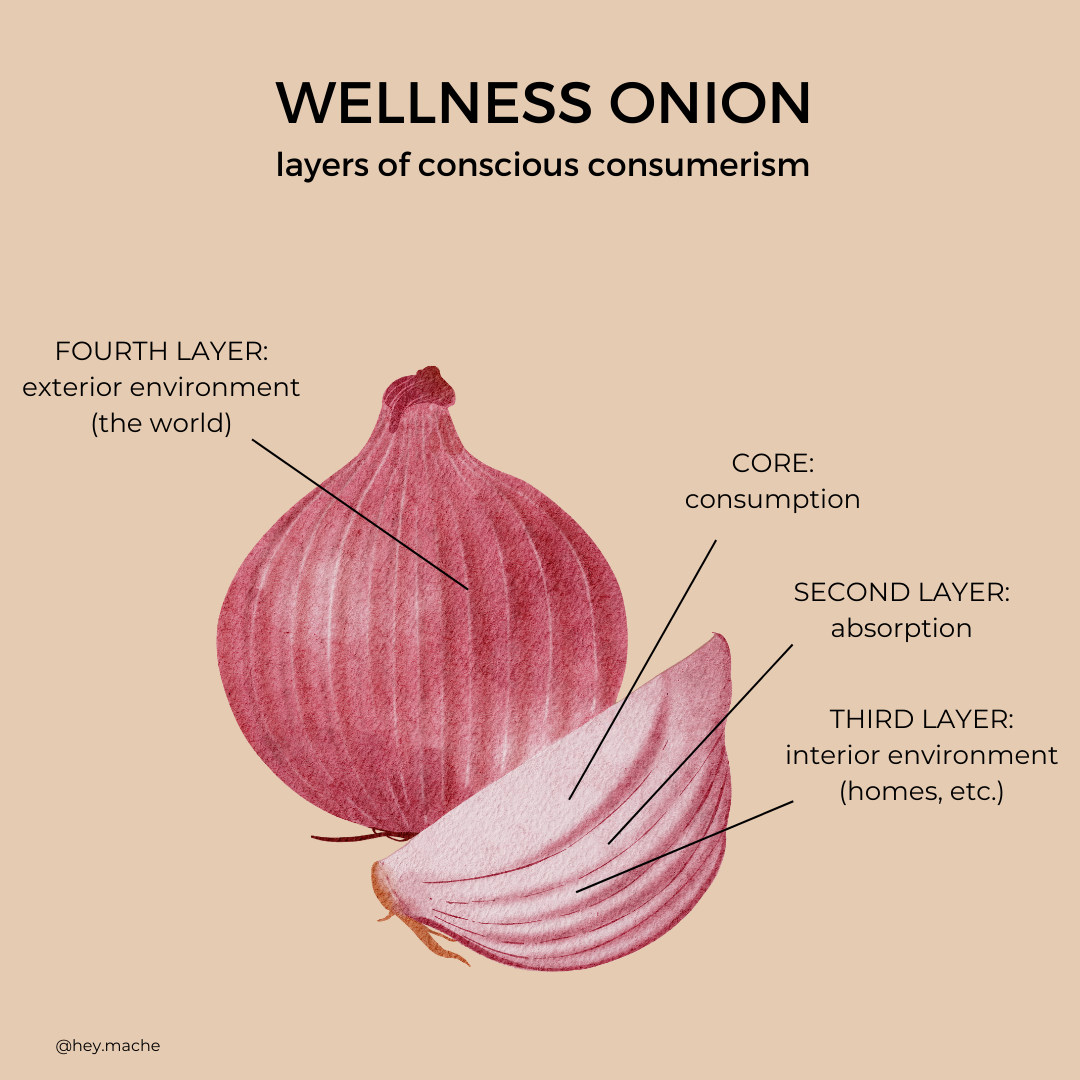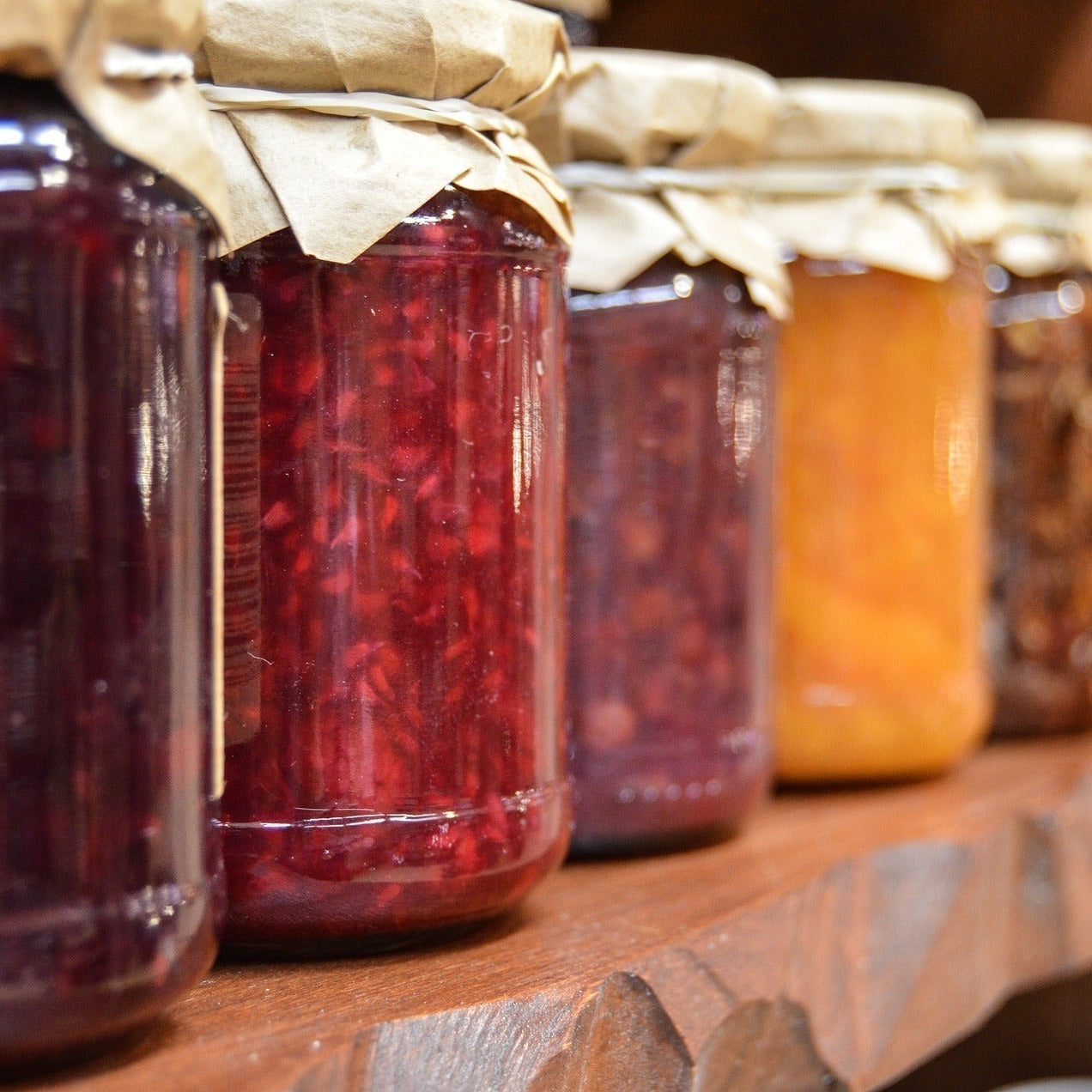The Day of the Dead, or "Día de los Muertos", is a mesmerizing and deeply rooted tradition celebrated primarily in Mexico, but its influence has reached many corners of the globe. This celebration, which spans over two days from November 1st to 2nd, is a beautiful amalgamation of ancient Mesoamerican cultures and Catholic beliefs. Its origins can be traced back to the indigenous Aztecs, Toltecs, and other Nahua people, who viewed death as a continuation of life. Instead of mourning the dead, they celebrated the lives of the departed with colorful festivals, dances, and rituals.
The Spanish conquest in the 16th century brought Catholicism to Mexico, leading to the fusion of indigenous beliefs with All Saints' and All Souls' Day observances. The result is the Day of the Dead, a unique blend of pre-Hispanic and Christian traditions.
Unlike many death-related observances worldwide that are marked by grief and somberness, the Day of the Dead stands out with its vibrant colors, lively music, and an overall joyous atmosphere. Altars or "ofrendas" are set up in homes, adorned with photographs, mementos, and favorite foods of the departed. Cemeteries come alive with families gathering to clean graves, light candles, and share stories of their loved ones.
However, as the world becomes more environmentally conscious, there's a growing need to celebrate such rich traditions with a new level of earth-awareness and sensitivity. The essence of the Day of the Dead is to honor the cycle of life and death, and what better way to do so than by also honoring the Earth that sustains us?
For those looking to embrace the Day of the Dead while also being eco-conscious, it's essential to understand the cultural significance of the celebration. By doing so, we can ensure that our eco-friendly adaptations are respectful and in line with the tradition's core values. This article delves deep into the cultural and historical aspects of the Day of the Dead, offering insights into its significance and the various ways it's celebrated across Mexico.
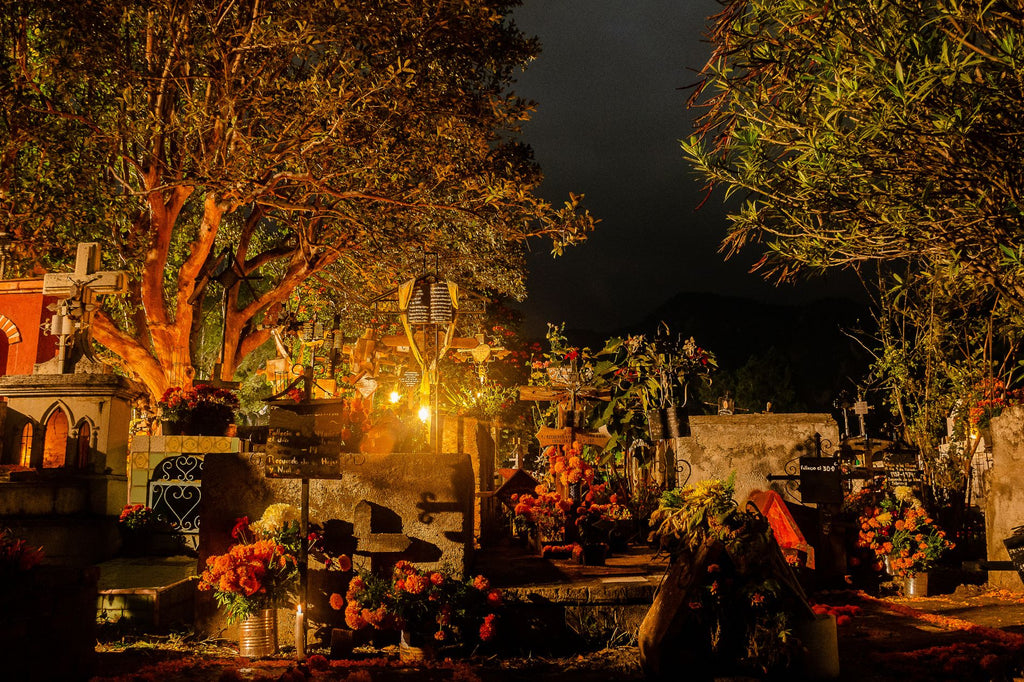
Understanding Cultural Appropriation + Celebrating Respectfully
Cultural appropriation refers to the act of adopting elements of one culture by members of another culture, particularly when the dominant culture borrows from a minority or historically oppressed culture. This can manifest in various ways, from fashion choices to adopting spiritual practices, and can often strip out the original context, meaning, and significance from the cultural practices.
When it comes to the Day of the Dead, the vibrant calaveras (skull) makeup, intricate costumes, and other symbols have gained popularity worldwide, especially around Halloween. However, without understanding and respecting the deep-rooted significance of these symbols, it's easy to inadvertently engage in cultural appropriation. Here are some insights and guidelines to celebrate the Day of the Dead without slipping into cultural appropriation:
-
Educate Yourself: Before incorporating any elements of the Day of the Dead into your celebrations, take the time to educate yourself about its history, significance, and traditions. This article from the Smithsonian Magazine provides a deep dive into the meaning behind the most common Day of the Dead altar symbols.
-
Avoid Costume-Based Celebrations: Wearing "sugar skull" makeup or dressing up as a "Day of the Dead" calavera, or skeleton character, without understanding its cultural context can be seen as disrespectful. Instead, focus on the core essence of the celebration: honoring and remembering the deceased.
-
Engage with Authentic Voices: If you're genuinely interested in celebrating the Day of the Dead, consider engaging with individuals or communities who have a personal and cultural connection to the tradition. Attend authentic Día de los Muertos events, workshops, or talks led by those who have grown up with this tradition.
-
Respectful Decor: If you choose to set up an "ofrenda" or altar, do so with genuine intentions of honoring the deceased. Avoid commercialized or "trendy" versions of traditional items. Remember, it's a sacred space, not a decorative element.
-
Acknowledge + Credit: If you're sharing your Day of the Dead celebrations on social media or elsewhere, acknowledge the cultural origins and give credit. This not only educates others but also shows respect to the tradition.
-
Support Indigenous Artisans: If purchasing Day of the Dead decorations, consider buying from local or indigenous artisans who create authentic, handcrafted items. This not only ensures authenticity but also supports the communities that hold this tradition dear.
-
Reflect on Intent vs. Impact: Your intentions might be pure, but it's essential to consider the impact of your actions on those from the culture. Listen to feedback, be open to learning, and be willing to make amends if needed.
In conclusion, la Día de los Muertos is a beautiful and profound celebration that offers a unique perspective on life, death, and remembrance. By approaching it with respect, understanding, and sensitivity, we can honor this tradition and its cultural richness without inadvertently engaging in cultural appropriation. As global citizens, it's our responsibility to celebrate with awareness and ensure that our actions uplift rather than diminish the cultures we draw inspiration from.
As we move forward, let's explore sustainable decoration ideas that not only reduce our environmental footprint but also pay homage to this age-old tradition with the respect and honor it deserves.
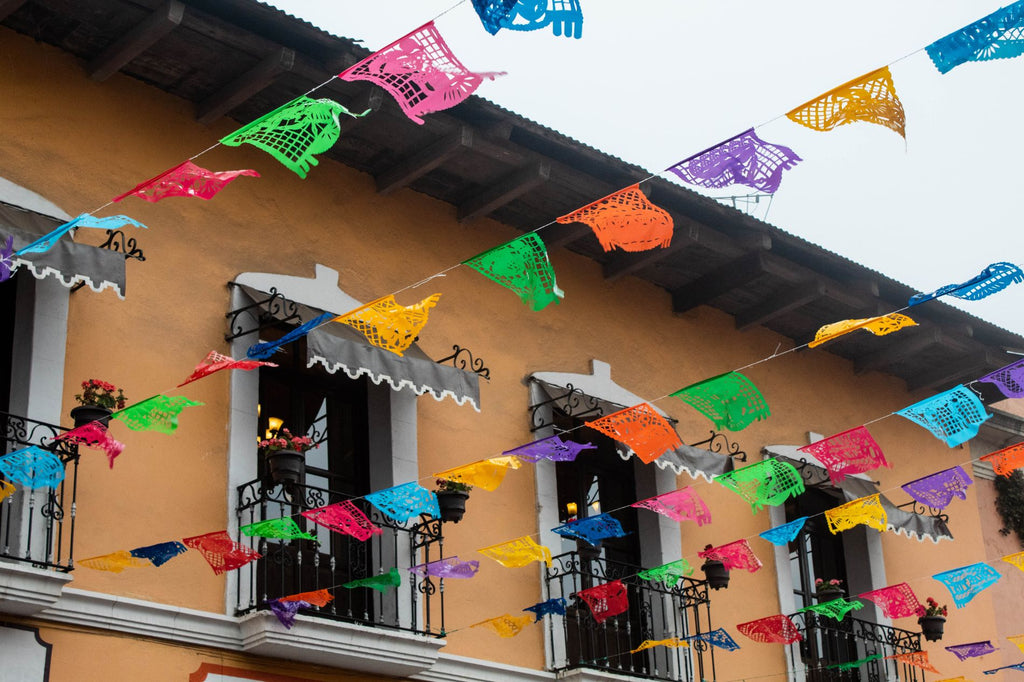
Supporting Artisans: Papel Picado in Authentic Style
"Papel picado", which translates to "perforated paper", is a cherished Mexican folk art that plays a pivotal role in Day of the Dead celebrations. These delicate and intricately designed banners, often depicting skeletons, flowers, and other motifs associated with the Day of the Dead, are traditionally hung in homes, cemeteries, and streets, adding a vibrant touch to the festive atmosphere.
Historically, papel picado was crafted using chisels and hammers to delicately punch out designs on stacks of colored tissue paper. While the lightweight tissue paper offers a beautiful translucent effect when hung against the light, the true beauty of these banners lies in the skill and tradition behind their creation.
In today's globalized world, it's more important than ever to support the artisans who keep these traditions alive. By purchasing authentic papel picado, you not only get a piece of art that's rich in cultural significance but also contribute to the livelihoods of the artisans who craft them.
World Market is a commendable platform that offers fair-trade papel picado, handmade by artisans in Mexico. By choosing to shop with them, you're supporting fair trade practices that ensure artisans are compensated fairly for their work. This not only promotes ethical consumerism but also helps in preserving cultural traditions for future generations.
Alternatively, if you're looking to make a more localized impact, consider visiting your local Mexican mercado or market. Investing in items from these markets means you're directly supporting local, small business owners and contributing to the economic well-being of the community.
In conclusion, as we approach the Day of the Dead, let's make choices that honor not just the departed but also the living artisans who work tirelessly to keep traditions alive. By supporting fair trade and local businesses, we ensure that our celebrations are both meaningful and impactful.

Edible Decorations: A Feast for the Eyes + the Palate
One of the most captivating aspects of the Day of the Dead celebrations is the vibrant array of foods that are both visually stunning and delectably delicious. Incorporating traditional Mexican dishes as part of your decor not only pays homage to the rich culinary heritage of the celebration but also offers a sustainable approach to decoration. After all, what better way to reduce waste than to consume your decorations?
Colorful Salsas
Salsas are a staple in Mexican cuisine and can be as varied as the regions of Mexico. From the fiery red of a tomato-based "salsa roja" to the vibrant green of a "salsa verde" made from tomatillos, these condiments can be served in beautiful bowls and spread out as part of your festive table decor. Garnish with fresh cilantro, diced white onions, or even pomegranate seeds for an added pops of color.
Guacamole
This creamy avocado dip is not just a crowd-pleaser but also a visual delight. The rich green of ripe avocados, contrasted with the reds of diced tomatoes and the whites of onions, makes for a dish that's as beautiful as it is tasty. Serve in a traditional "molcajete" (lava stone mortar) for an added touch of authenticity.
Sugar Skulls
While traditional sugar skulls ("calaveras de azúcar") are often used as decorations and not meant for consumption, you can create edible versions using natural ingredients. Consider making sugar skulls using organic sugars and natural food colorings derived from plants, vegetables, and spices. Beet juice, for instance, can provide a lovely red hue, while turmeric can be used for yellow. These edible sugar skulls can be a fun activity for kids and adults alike, decorating them with icing, colorful sprinkles, and even chocolate. Interested in crafting your own? Try out this recipe!
Tamales, Pan de Muerto, and More
Other traditional dishes like tamales (steamed corn dough with fillings) and "pan de muerto" (bread of the dead) can also double up as decorations. The pan de muerto, with its round shape and bone-like patterns on top, is especially significant during the Day of the Dead and can be placed as a centerpiece on your table.
By opting for edible decorations, you're not only ensuring a reduction in waste but also providing a sensory experience for your guests. The aroma of freshly made dishes, the visual appeal of colorful foods, and the flavors of traditional recipes all come together to create a celebration that's sustainable, authentic, and deeply rooted in Mexican culinary traditions.
For those looking to dive deeper into traditional Mexican recipes, Mexico in my Kitchen offers a plethora of authentic dishes, complete with detailed instructions and the cultural significance of each dish. Another great resource is Pati Jinich, where Chef Pati Jinich shares her passion for Mexican cuisine and its rich history. Both these platforms provide insights into the culinary traditions of the Day of the Dead, ensuring that your celebration is both delicious and culturally informed.
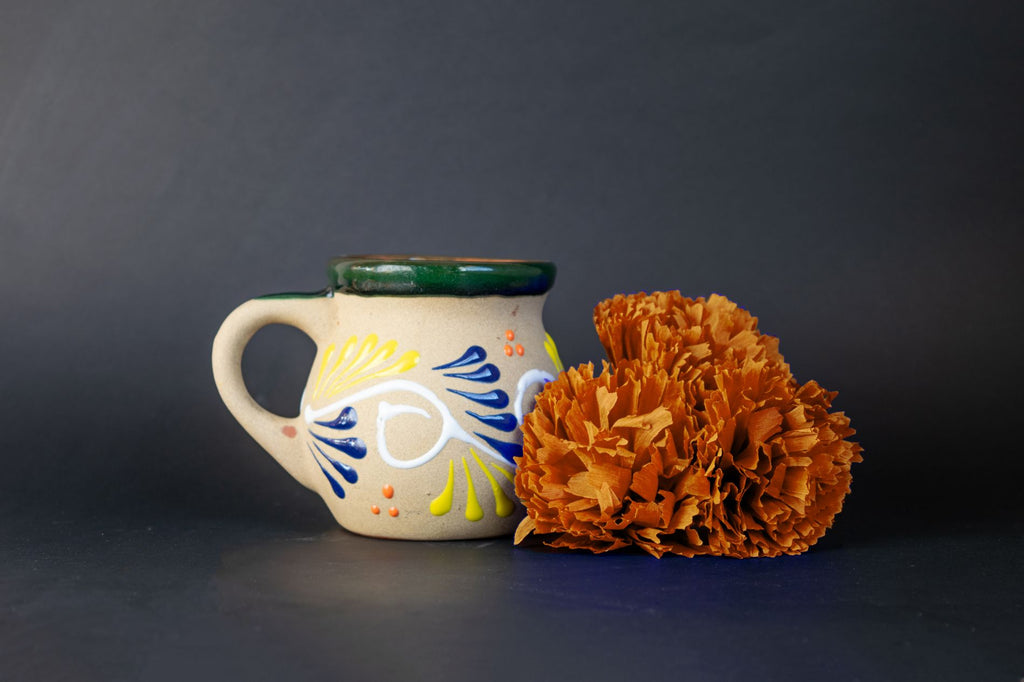
Marigold + Paper Flowers: Symbols of Life + Memory
The vibrant hues of marigolds, known as "cempasúchil" in Spanish, are synonymous with the Day of the Dead celebrations. These bright orange and yellow flowers are more than just visually captivating; they hold deep cultural and spiritual significance in the observance of this holiday.
The Significance of Marigolds
Marigolds are often referred to as the "flower of the dead." Their radiant color is believed to represent the sun, which in Aztec mythology guides the spirits on their journey to the underworld. During the Day of the Dead, the petals of these flowers are scattered from the cemetery to the home, creating a path for the spirits to follow. The strong, aromatic scent of the marigold is also believed to attract spirits and guide them back to the world of the living.
Beyond their spiritual significance, marigolds are also cherished for their practical benefits. These flowers are known to dry beautifully, retaining much of their color and form. This means that once the celebrations are over, marigolds can be preserved as keepsakes, serving as a lasting reminder of the connection between the living and the departed. They can be used in dried flower arrangements, wreaths, or even as bookmarks, ensuring that their beauty and significance are cherished long after the festivities.
Sustainable Paper Flowers
For those looking to incorporate eco-friendly alternatives or add variety to their floral decorations, handmade paper flowers are an excellent choice. Crafted with care and attention to detail, these flowers capture the essence of the traditional marigold without the need for cultivation or transportation. Available in a range of colors and designs, paper flowers are not only reusable but also serve as beautiful keepsakes. They can be used year after year, making them a sustainable and sentimental choice for Day of the Dead celebrations.
For those interested in purchasing handmade paper flowers that capture the spirit of the Day of the Dead, Etsy offers a wide selection of artisans who craft these flowers with precision and passion. Whether you're looking for traditional marigold replicas or a variety of colorful blooms, Etsy's community of crafters provides options that are both eco-friendly and culturally respectful.
In conclusion, whether you choose the traditional marigold or its sustainable paper counterpart, the essence remains the same: honoring the spirits of the departed and celebrating the cycle of life and death. By opting for sustainable decorations, you're not only reducing your environmental footprint but also ensuring that the rich traditions and values of the Day of the Dead are preserved for generations to come.
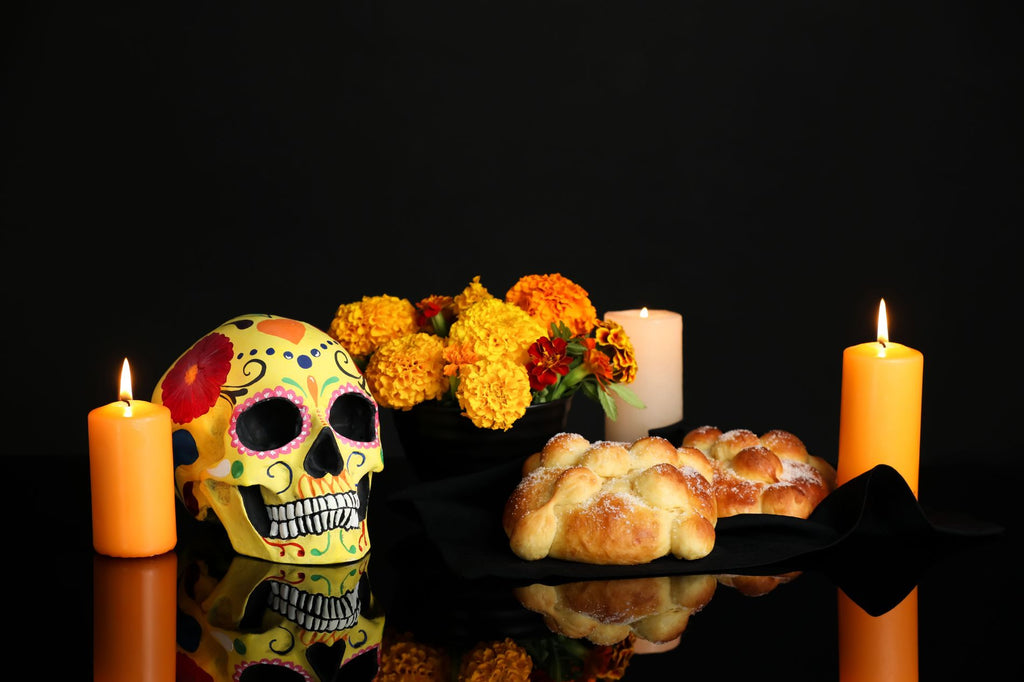
Beeswax + Paraffin-free Candles: Lighting the Way Sustainably
Candles have long held a sacred and symbolic place in many cultural and religious ceremonies around the world. In the context of the Day of the Dead, they play an indispensable role, illuminating altars and gravesites, guiding spirits back to the realm of the living, and representing the fire of life. Their gentle glow creates an ambiance of reverence, remembrance, and connection between the living and the departed.
The Environmental Impact of Traditional Candles
Many commercially available candles are made from paraffin wax, a byproduct of petroleum refining. When burned, paraffin candles release a range of pollutants, including carcinogenic compounds. These emissions can contribute to indoor air pollution, posing potential health risks to individuals and pets. Moreover, the production and refining of petroleum have significant environmental consequences, from oil spills to greenhouse gas emissions.
The Benefits of Beeswax Candles
Beeswax candles are a natural and sustainable alternative to paraffin. They are crafted from the wax produced by honeybees, making them a renewable resource. When burned, beeswax candles produce a bright, clean flame and release a subtle, sweet aroma. Additionally, beeswax candles tend to burn longer and drip less compared to their paraffin counterparts.
Etsy has a wide range of skull-shaped beeswax candles!
Paraffin-free Plant-based Candles
For those who prefer vegan options, there are candles made from plant-based waxes like soy, coconut, and palm. It's essential to choose candles made from sustainably sourced ingredients, especially when it comes to palm wax, given the environmental concerns associated with palm oil production. These plant-based candles offer a cleaner burn, free from the toxins associated with paraffin.
Making the Sustainable Choice
By opting for beeswax or paraffin-free candles, you're making a choice that's not only better for the environment but also for your health. These candles provide a cleaner, brighter burn, enhancing the ambiance of your Day of the Dead celebrations while minimizing the health impacts to the living, as well as planetary impacts.
For those looking to purchase eco-friendly candles for their altars, many local artisans and online retailers offer a range of options. Whether you're drawn to the natural allure of beeswax or the sustainable promise of plant-based waxes, these candles ensure that the light you offer to guide spirits back home is as pure and respectful as your intentions.
In essence, as we honor the departed and celebrate the continuity of life, it's vital to make choices that reflect our commitment to a sustainable future. By choosing eco-friendly candles, we can ensure that our tributes to loved ones are not only heartfelt but also harmonious with the planet we all share.

Paper Mâché Masks: A Timeless Craft with Modern Eco-Significance
Throughout history, masks have held a special place in various cultures, symbolizing everything from spiritual entities to societal roles. They've been used in religious ceremonies, theatrical performances, and festive celebrations for millennia. The Day of the Dead, with its rich tapestry of traditions, is no exception. Masks, particularly those depicting skulls or "calaveras", play a pivotal role in the festivities, serving as a poignant reminder of the cyclical nature of life and death.
The Environmental Concern with Plastic Masks
In today's fast-paced world, the convenience of plastic has led to its ubiquitous presence, including in the form of cheap costumes and masks. While plastic masks might be readily available and affordable, their environmental cost is steep. These masks, often discarded after a single use, add to the mounting crisis of plastic pollution across the globe. Given that plastic can take centuries to break down (if ever!), each plastic mask thrown away lingers in our environment, posing threats to wildlife and ecosystems.
Paper Mâché: Merging Artistry with Eco-Consciousness
Paper mâché, which literally translates to "chewed paper", is an age-old craft that has been practiced in various forms across different cultures. From the elaborate masks of Venice's Carnival to the vibrant piñatas of Mexican fiestas, paper mache has been a favorite medium for artisans.
The process involves soaking strips of paper in a glue mixture, typically made from water and flour, and layering them onto a mold. Once dried, the result is a sturdy yet lightweight object. Given that the primary material is paper, these masks are biodegradable, making them an eco-friendly alternative to plastic.
Beyond their environmental benefits, paper mâché masks offer a unique canvas for artistic expression. They can be painted, adorned, and embellished to reflect personal styles and themes. This hands-on approach adds a personal touch to the celebration, making it even more memorable.
For those keen on embracing this sustainable craft, numerous online tutorials guide enthusiasts through the process. Websites like Mexic-Arte Museum provide detailed step-by-step instructions, ensuring that even beginners can create beautiful masks.
Incorporating Tradition with Responsibility
As global awareness about environmental issues grows, it's heartening to see traditional practices like paper mache being embraced not just for their cultural significance but also for their sustainability. By choosing paper mâché over plastic, we pay homage to the rich traditions of the Day of the Dead while also making a conscious choice to protect our planet.

Eco-friendly Face Paint: Embrace the Tradition with Earth-Friendly Hues
Face painting is a deeply rooted tradition in many cultures, and during the Day of the Dead celebrations, it takes on a particularly poignant significance. The striking "calavera" or skull design is not just a festive decoration; it's a symbolic representation of death and rebirth, a nod to the cyclical nature of life.
The Hidden Cost of Conventional Face Paint
While the vibrant colors and intricate designs are visually captivating, there's often an unseen cost. Many commercially available face paints are laden with chemicals, artificial fragrances, and synthetic dyes. Using these can lead to skin irritations, allergic reactions, and other health concerns. Furthermore, when washed off, these chemicals can find their way into water systems, posing potential harm to aquatic life and contributing to water pollution.
The Sustainable Shift to 'Green' Face Paint
In recent years, there's been a growing awareness about the ingredients used in cosmetics and personal care products. This has paved the way for eco-friendly face paints that prioritize both human and environmental health. Made from natural, plant-derived pigments, these paints are devoid of harmful toxins, parabens, and synthetic dyes. They offer a rich palette of colors, allowing for creative expression without compromising safety.
Brands like Natural Earth Paint have championed this green movement in face paint. Their products are crafted using pure, natural ingredients, ensuring they're gentle on the skin. Suitable for all ages, these paints are also biodegradable, ensuring that post-celebration clean-up doesn't harm Mother Earth.
As we immerse ourselves in the vibrant traditions of the Day of the Dead, it's essential to make choices that align with a sustainable and health-conscious ethos. Opting for eco-friendly face paints is a small yet impactful step in this direction. It allows us to honor traditions, celebrate with gusto, and ensure that our festivities leave a positive, not detrimental, mark on the planet.
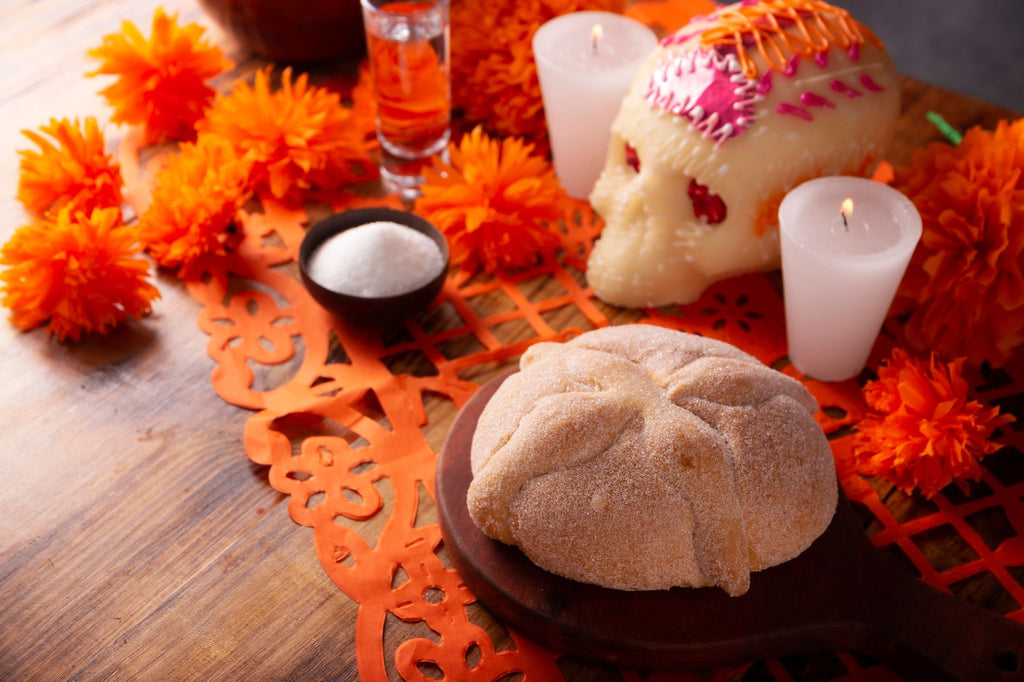
Sustainable Dining: A Feast that Respects Tradition + the Planet
The Day of the Dead is as much about celebrating life as it is about honoring the deceased. Central to this celebration is the act of sharing meals, a universal expression of community and remembrance. In many regions, families congregate in cemeteries, setting up picnics beside the graves of their loved ones, reminiscing about old times, and creating new memories.
The Environmental Footprint of Festive Dining
Such gatherings, while heartwarming, can inadvertently lead to environmental concerns. The convenience of disposable plates, cutlery, and containers often results in heaps of garbage, much of which is non-biodegradable. Single-use plastics, in particular, pose a significant environmental challenge, taking hundreds of years to decompose and often ending up in our oceans, harming marine life.
Eco-conscious Dining Alternatives
Celebrating sustainably doesn't mean compromising on the essence of the tradition. It's about making informed choices. Opt for reusable containers made of glass or stainless steel to pack your meals. Bamboo cutlery, cloth napkins, and metal or glass straws can replace their plastic equivalents, reducing waste and elevating the dining experience.
For those occasions when disposables are necessary, there are eco-friendly alternatives that don't harm the environment. Plates made from pressed and dried Palm leaves are a sustainable choice. They decompose naturally and quickly, leaving no trace behind. Their rustic appearance and unique texture also add an authentic touch to the celebration. Brands like Boho and Chic have curated a range of these biodegradable dining essentials, marrying aesthetics with sustainability.
The Day of the Dead teaches us about the cyclical nature of life and the interconnectedness of all beings. As we gather to honor the memories of those who have passed on, it's equally crucial to show respect for the planet that sustains us. By choosing sustainable dining options, we ensure that our celebrations leave a positive legacy for future generations, echoing the reverence and love we feel for our departed loved ones.

Embrace Day of the Dead Tradition + Sustainability
The Day of the Dead is a celebration that transcends time, bridging the past with the present, the living with the departed. It's a testament to the enduring human spirit, our capacity to remember, to love, and to celebrate life in all its facets. As the world evolves and becomes more interconnected, so too does our understanding of the broader implications of our actions. The choices we make today, from the decorations we use to the food we consume, have far-reaching consequences on the environment and future generations.
In this age of environmental consciousness, it's inspiring to see that traditions as ancient and profound as la Día de los Muertos can adapt and evolve. By incorporating sustainable practices into our celebrations, we're not only paying homage to our ancestors but also laying the groundwork for a future that's in harmony with the planet.
It's a reminder that respect – whether for the departed, for cultural traditions, or for the Earth – is a value that transcends boundaries and generations. As we light our eco-friendly candles, don our paper mâché masks, and gather around sustainable feasts, we're sending a powerful message: that it's possible to honor the past while building a sustainable future.
In the end, the Day of the Dead is not just a celebration of those who have passed on, but a celebration of life itself – in all its beauty, complexity, and interconnectedness. By choosing to celebrate in an eco-friendly manner, we're ensuring that the legacy of love, remembrance, and respect continues for generations to come.
Thank you for joining us on this journey of understanding and adaptation. May your Day of the Dead celebrations be filled with joy, reflection, and a renewed commitment to our shared home – Planet Earth.
Interested in applying mindfullness to other holidays? Read our journal post "The 2023 Healthy Holiday Gift Guide: 50 Ways to Align your Holiday Shopping List with your Holistic Values"

